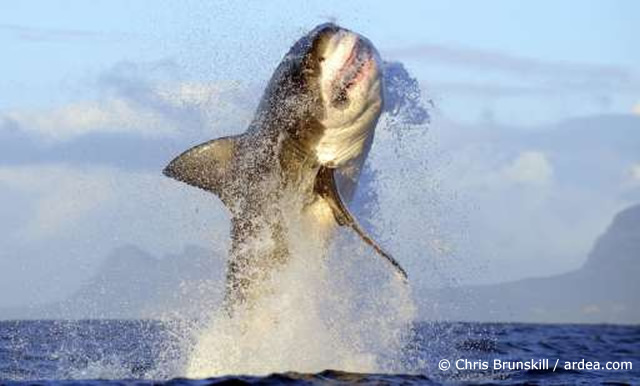
Another Sighting of Great White Shark in False Bay, After None for 18 Months
A second sighting of a Great White Shark in False Bay has been made by South African National Parks (SANParks) marine biologist, Dr Alison Kock. Speaking to John Maytham on Cape Talk, Dr Kock said she spotted the Great White Shark near Macassar Beach in the False Bay area, during an aerial survey on Saturday. […]

A second sighting of a Great White Shark in False Bay has been made by South African National Parks (SANParks) marine biologist, Dr Alison Kock.

Speaking to John Maytham on Cape Talk, Dr Kock said she spotted the Great White Shark near Macassar Beach in the False Bay area, during an aerial survey on Saturday.
She said at this stage it’s impossible to say whether this was a second sighting of the same shark spotted by Gregg Oelofse off Seal Island further north a few days ago, or a sighting of a second shark.
“They were similar in size – about 4 metres, which is fairly average for False Bay,” said Dr Kock.
Oelofse’s sighting was the first in 20 months, bringing relief to him (a cage diving operator) and others who rely on the Great White Sharks as one of False Bay’s biggest tourist attractions. The cage diving industry supports about 750 jobs in the area.
Dr Kock said the aerial survey was conducted because of Oelofse’s sighting, to try get a better idea of what’s happening on the in-shore and learn more. She says they saw a lot of other marine wildlife in the bay – other species of sharks, stingrays etc – but only the one shark.
Until there are more consistent sightings, experts can’t know if these two sightings signal a return of the Great White to False Bay, or are a one-off.
There’s been a lot of debate over why the White Sharks disappeared from False Bay.
“We have got evidence to suggest that Orcas have played a role,” says Dr Kock, referring to two killer whales Starboard and Port, “but other factors – such as changing environmental conditions along our oceans and changes in the distribution of their food sources” may have also played a part.
It’s not certain whether the sharks that used to be in False Bay have moved up to Port Elizabeth, gone deep sea or died, but Dr Kock says “at least some of them have moved somewhere else”.
She says there’s existing evidence over the longer term that when you see increases in white shark sightings in the Western Cape, there’s a decrease of sightings in the Eastern Cape, and vice-versa.
These are also not just South Africa’s sharks – they move up into Mozambique and Madagacar, and many variables affect their movements – their size, gender and age.
“The big pictures is still evading our deep understanding of what’s going on,” says Dr Kock, saying that much more research and gathering of data is required.
She says there may be a decline in the local population’s numbers. “We do know that they spend a lot of time on the high seas, we do know there are threats out there in terms of them being caught by long liners and other industrial fisheries, we do know that in Mozambique there’s a lot of gill netting taking place where these animals are being captured… but none of us have got data on the long term sightings.”
There’s debate over the size of the Great White Shark population – varying between 500 and 2,000 (which is still a low number for a population).
Dr Kock, who works for the Cape Research Centre, says at this stage there’s not enough strong evidence to study the pattern of the local population – whether it’s increasing, decreasing or stable.

